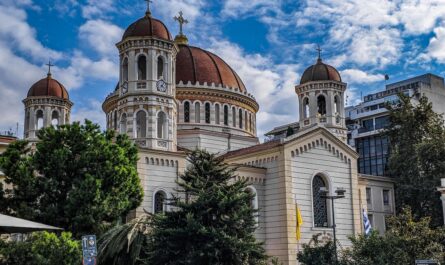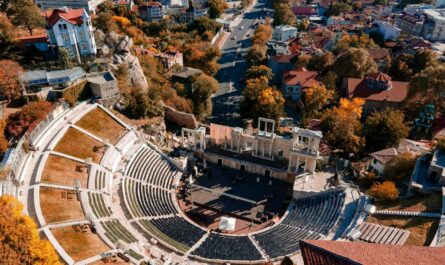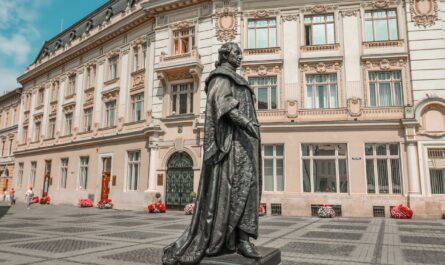Nestled on the shores of the Ionian Sea, the ancient city of Butrint stands as a testament to the rich history and cultural heritage of Albania. Recognized as a UNESCO World Heritage Site, Butrint is a captivating archaeological gem that unveils the layers of civilizations that have left their mark on this remarkable corner of the Balkans.
Unraveling the Layers of History
Butrint’s history dates back over 2,500 years, and its archaeological remains showcase the diverse cultures that once thrived on this site. The city was initially inhabited by the Illyrians, an ancient Indo-European people, before being transformed into a Roman colony around the 2nd century BC. Under Roman rule, Butrint flourished as a strategic trading and military center, leaving behind impressive structures such as a well-preserved amphitheater, public baths, and a forum.
The Byzantine era saw Butrint evolve into an important Christian center, evident in the construction of basilicas and baptisteries. The city then fell under the influence of the Venetians and the Ottomans, each leaving their own architectural imprints on this historical canvas.
Architectural Marvels
One of the standout features of Butrint is the breathtaking amphitheater, an ancient arena that once echoed with the cheers of Roman spectators. This well-preserved structure is a testament to the advanced engineering skills of the time and provides visitors with a glimpse into the vibrant cultural life of the city.
The Lion’s Gate, an imposing entrance adorned with a relief of a lion, stands as a symbolic guardian to Butrint. This gate is a fascinating example of ancient craftsmanship and is a must-see for anyone exploring the city’s historical riches.
The Baptistery, a beautifully preserved Christian structure, reflects the city’s religious transition over the centuries. Its intricate mosaics and elegant design transport visitors back to a time when Butrint was a flourishing Byzantine center of worship.
Natural Beauty
Butrint is not only a treasure trove of archaeological wonders but also a haven of natural beauty. Surrounded by lush greenery and overlooking the serene waters of the Ionian Sea, the site offers a harmonious blend of history and nature. The Butrint National Park, where the archaeological site is located, provides a picturesque backdrop for exploration, with walking trails allowing visitors to immerse themselves in the tranquility of the landscape.
Preservation Efforts
The significance of Butrint prompted its inscription as a UNESCO World Heritage Site in 1992. The designation recognizes the city’s outstanding universal value and underscores the need for ongoing preservation efforts. The Albanian government and international organizations collaborate to ensure the protection and conservation of Butrint, safeguarding this archaeological gem for future generations.
Butrint’s Eclectic Cultural Tapestry
Butrint’s allure goes beyond its architectural marvels and extends to the diverse cultural influences that have converged within its ancient walls. The city’s ability to absorb and adapt to various civilizations over the centuries has created a cultural tapestry that is as rich and varied as the history it encapsulates.
The Venetian influence, for instance, is evident in the iconic defensive walls and towers that surround Butrint. These structures, built during the Venetian rule in the 14th century, served as formidable barriers against external threats. The juxtaposition of these medieval fortifications with the classical ruins creates a unique visual narrative that reflects the city’s layered past.
Mysteries of the Past
Butrint is not without its mysteries. The well-preserved archaeological site continues to yield surprises, and ongoing excavations unearth new artifacts and insights into the lives of the people who once called this city home. Archaeologists and historians work tirelessly to decipher the clues left behind, providing us with a deeper understanding of Butrint’s significance in the ancient world.
One such enigma lies in the Sanctuary of Asclepius, a sacred space dedicated to the Greek god of healing. The presence of intricate mosaics and votive offerings suggests that Butrint was not only a center of commerce and governance but also a hub for spiritual practices and rituals. The exploration of these mysteries adds an element of intrigue to the visitor’s experience, inviting them to contemplate the lives and beliefs of Butrint’s past inhabitants.
A Journey Through Time
As visitors meander through the cobbled streets and expansive ruins, they are transported through the epochs, witnessing the evolution of Butrint from a bustling Roman colony to a Byzantine stronghold and later a Venetian outpost. Each era has left its mark, creating a palimpsest of history that is waiting to be explored.
The Great Basilica, an imposing Christian structure, is a testament to Butrint’s transformation into a religious center during the Byzantine era. The grandeur of its architecture and the remnants of intricate frescoes provide a glimpse into the spiritual life of the community that once gathered within its walls.
Butrint Beyond the Ancient Walls
While the archaeological site takes center stage, Butrint’s historical narrative extends beyond its ancient walls. The nearby Vivari Channel, once a vital waterway for trade, adds a maritime dimension to the city’s history. Exploring the surrounding landscapes and waterways provides visitors with a holistic understanding of Butrint’s strategic importance in the region.
The Call to Preservation
Preserving Butrint is not just a matter of safeguarding physical structures; it is also about preserving the intangible essence of a place that connects us to our collective human history. The ongoing efforts to conserve and protect Butrint underscore the importance of maintaining a delicate balance between tourism, research, and environmental preservation.
Cultural Festivals and Events
The spirit of Butrint extends beyond the silent echoes of its ancient stones and comes alive during cultural events and festivals. Throughout the year, Butrint hosts various celebrations that bring the site to life with music, dance, and theatrical performances. These events not only showcase the vibrant cultural heritage of Albania but also create a dynamic platform for locals and visitors to engage with the history and traditions of Butrint in a more immersive way.
The Butrint Summer Festival, for example, is a celebration of music and arts held against the backdrop of the ancient amphitheater. As the sun sets over the Ionian Sea, the amphitheater, once a venue for gladiatorial contests, transforms into a stage for contemporary artists, providing a unique fusion of the old and the new.
Ecotourism in Butrint National Park
Beyond its archaeological wonders, Butrint National Park offers a haven for nature enthusiasts and ecotourists. The park encompasses diverse ecosystems, including wetlands, forests, and lagoons, providing a habitat for a wide range of flora and fauna. Birdwatchers, in particular, will be delighted by the diverse avian species that inhabit the park, making it a prime destination for eco-friendly tourism.
Guided nature walks and boat tours allow visitors to explore the ecological diversity of the region while appreciating the harmonious coexistence of history and nature. The Butrint Wetlands, recognized as a Ramsar site, further emphasize the importance of sustainable tourism practices to protect the fragile ecosystems within the park.
Culinary Delights
No exploration of a region is complete without savoring its culinary delights. The vicinity of Butrint offers a culinary journey through the flavors of Albanian cuisine. Local restaurants and cafes serve traditional dishes that showcase the richness of the country’s gastronomic heritage. From freshly caught seafood to hearty mountain specialties, visitors can indulge in a diverse array of culinary experiences.
Connecting Communities
Butrint has become a focal point for community engagement and empowerment. Local initiatives and community-led projects aim to involve residents in the preservation and promotion of their cultural heritage. These efforts not only contribute to the sustainable development of the region but also foster a sense of pride and ownership among the local population.
The Future of Butrint
As Butrint continues to unveil its secrets and captivate the hearts of those who wander its ancient paths, the challenges of balancing conservation with tourism and development persist. The ongoing commitment to responsible tourism, community involvement, and environmental stewardship will play a pivotal role in ensuring that Butrint’s legacy endures for generations to come.
In conclusion, the ancient city of Butrint transcends the boundaries of time, offering a multifaceted experience that encompasses archaeology, culture, nature, and community. As visitors explore its archaeological wonders, engage in cultural festivities, savor local cuisine, and immerse themselves in the surrounding natural beauty, they become part of a living narrative that weaves together the threads of Butrint’s past, present, and future. This archaeological gem, nestled on the shores of the Ionian Sea, invites us not only to witness history but to actively participate in the ongoing story of a place that remains eternally captivating.



